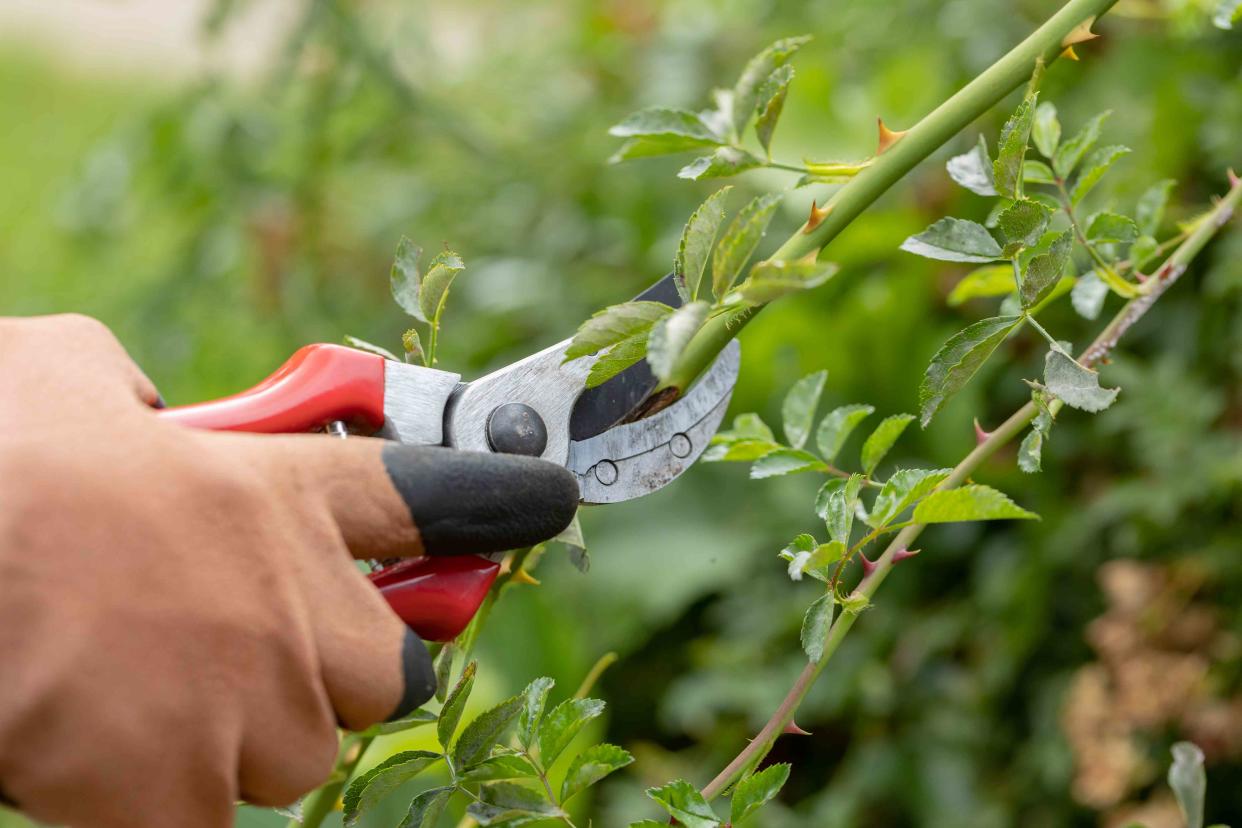What Is Pruning? Here's Why It's Essential In Every Garden

Getty Images
Pruning is defined as the manual removal of branches to alter a plant’s health and form. It's a term most often used when discussing the care of trees and woody shrubs. Since most home gardens include both, pruning is an essential task that’s both an art and a science. The art comes from your ability to create a pleasing shape and the science is the techniques you use to maintain the health and productivity of the plant while protecting your home, vehicle, and other structures.
Related: 25 Easy Evergreen Shrubs To Use As Foundation Plants
Types of Pruning
The method you use when pruning depends on your final goal for the plant.
Selective Branch Removal: The most minimal type of pruning, selective pruning refers to removing dead, diseased, or broken branches and suckers coming up from the roots to improve the structure of the plant.
Directing Growth: Pruning helps train young trees and shrubs to develop a strong structure. Crossing branches, branches that curve towards the center of the main leader trunk, and multiple leader branches are removed. As a tree grows, the lower branches are often removed to gradually raise the crown of the tree.
Size Reduction: Reduction cuts decrease the height (topping) and spread of a tree or shrub. Pruning also improves the health of the plant by reducing the above-ground portion of the plant relative to the root system.
Thinning: Removes branches on individual limbs to create even distribution throughout the crown of the tree. Thinning enhances light penetration and is especially beneficial for trees and shrubs that grow quickly to inhibit overgrowth.
Raising: A selective pruning technique to remove low-hanging branches and provide vertical clearance for people or vehicles.
Related: 32 Landscaping Ideas For Your Yard That You'll Cherish In Every Season
Pruning Equipment
Sharp, well-maintained tools will make pruning easier.
Pruning shears: Select a pair that can cut branches up to 3/4-inch for shrubs and small trees.
Loppers: Similar to pruning shears, loppers have long handles that provide better leverage needed to cut branches up to 1 1/2 inches in diameter.
Garden shears: Smaller shears for pruning green growth on hedges or small plant stems.
Hand saws: Used to cut branches over one inch in diameter
Pole saws: Long-handled hand saw to reach upper limbs without the use of a ladder.
Small chain saws: Gas, electric, and battery-powered chain saws are needed for branches larger than 2 inches in diameter. They should be used with extreme caution and never for cutting limbs above your shoulders.
Principles of Pruning
While pruning removes plant material, it also stimulates and directs new growth. Heavy pruning may cause the plant to produce excessive new, vigorous branches. Overgrown, mature plants that have lost vigor may benefit from heavy pruning, but younger plants may become unruly. A good rule of thumb is to remove no more than one-third of a plant each year. Over-pruning can cause excessive stress and excessive regrowth weakening the tree or shrub.
Pruning Techniques and Timing
Pruning techniques vary depending on the type of plant and what you wish to accomplish. There are two basic types of pruning cuts, heading and thinning. Heading removes the end of shoots or limbs and stimulates regrowth near the cut. This results in thick compact growth and a loss of natural form. Thinning removes the entire shoot or limb from the main branch or trunk. It is the least invigorating type of pruning cut and provides a more natural growth form.
The best time to prune depends on the type of plant. Most thinning cuts are made when the plant is dormant. Heading is usually done during a season of active growth. It is essential to understand the type of plant you are pruning. Spring flowering trees and shrubs (azaleas, dogwoods, forsythia, oakleaf hydrangeas) should be pruned shortly after flowering is over. Summer flowering woody plants (crepe myrtle, beautyberry, glossy abelia, nandina) should be pruned before spring growth begins.
It should be noted that dead, diseased, or damaged branches can be removed at any time of the year to protect the health of the plant.
Difference Between Pruning and Trimming
Pruning and trimming woody plants use many of the same tools and both involve making cuts to the plant. Pruning usually refers to making cuts that improve a plant’s health, structure, and fruit or bloom production. Trimming refers to cosmetic cuts and focuses on maintaining the appearance of the plant.
Frequently Asked Questions
How often should I prune my trees?
If a tree has been placed properly in the landscape, it does not require frequent pruning beyond removing broken or dead branches. Fruit and nut trees should be pruned yearly for the best harvest. Trees that have overgrown their space require pruning every two to three years.
Can pruning help rejuvenate an overgrown shrub?
Yes, there are two methods. One technique is a three-year plan. In late winter, remove one-third of the largest, oldest stems at ground level. At the same time, the following year prune out one-half of the remaining old stems and some of the new growth. Finally, in the late winter of the third year remove all of the remaining old wood.
The second technique is more drastic and involves cutting back the entire shrub to within 4 to 6 inches of the ground in March or early April. This severe pruning will encourage a large number of new shoots to develop during the growing season. Resume a normal pruning schedule in the following years.
What are the risks of improper pruning?
Improper pruning, especially at the wrong time of the year, can result in the death of the tree or shrub.
For more Southern Living news, make sure to sign up for our newsletter!
Read the original article on Southern Living.
